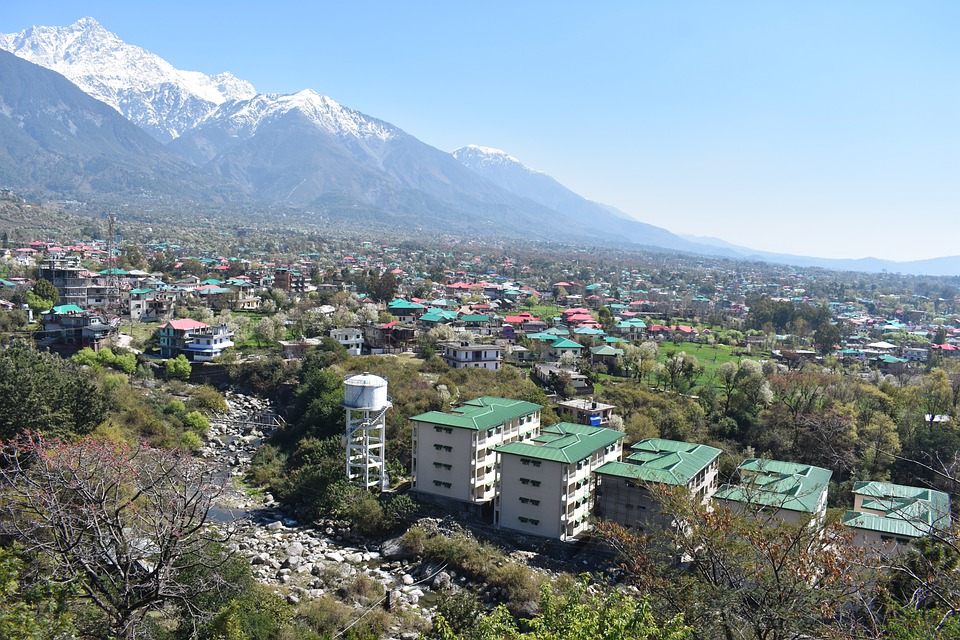Table of Contents
ToggleThe Dhauladhar Mountain Ranges
The Dhauladhar mountain range is a branch of the Himalayan mountain chain extending from Chamba, Kangra towards Mandi in Himachal Pradesh. Dhauladhar is the southern branch of the main outer Himalayan mountain range. The Dhauladhars have a peculiar topography with extremely rocky mountains consisting of a lot of granite. On the other hand, the range also contains a lot of slate, limestone and sandstones. Therefore if anyone decides to ascend from any side would be a risky proposition, given the vertical inclination. This calls for a tough trekking and mountaineering. However, the scenery from any of the passes of the Dhauladhar towards Pir Panjal and the Greater Himalayas is most captivating and spectacular allowing an unobstructed view of the mountain ranges and deep valleys with their far-flung, snow-clad, dome-like enchanting peaks.

Trekking and Mountaneering in Dhauladhars
This mighty range has vast trekking, mountaineering and skiing potential and is known for its unexplored and improvised treks. There is very little habitation on the range given the harsh conditions. But meadows abound near the crest providing rich pastures for grazing where large numbers of Gaddi shepherds take their flocks. The top of the crest is buried under vast expanses of thick snow. The range has rich flora and fauna and its exquisite beauty attracts mountain lovers who return many times over to savoir the delightful trails and there are many of them.
Hidden Lakes of Dhauladhars
The Dhauladhar mountain ranges boast approximately 30 passes, each concealing one or two hidden lakes. In total, it’s estimated that these ranges harbour 22 glacial lakes or even more. These lakes are steeped in mythology and hold immense sacredness for local residents who make pilgrimages to these lakes on auspicious days every year. Believed to be the abode of Lord Shiva, these lakes are considered holy and revered. Among them, the seven lakes of Kangra, often referred to as the ‘7 lakes of Dhauladhars,’ stand out as particularly prominent.
1. Nag Dal Lake.
From Triund after trekking appx 6 km, the first place you reach is Lahesh cave. From Lahesh, passing through a narrow trail for another 6-7 km, you reach Nag Dal. It is situated at a height of 3800 meters.
Folklore about Nag Dal Lake
The folklore about this sacred place is that, during the rule of Raja Bhagsu there was once a severe drought in his capital. The local chiefs requested the king to do something or else the people would leave his kingdom. The king therefore set out in search of water. After about 3 days of searching, he reached the Sacred Nag Dal (Lake) at a height of 18000ft. This lake was very big and had a lot of water. Raja Bhagsu used trickery to fill the water of the lake into a small vessel. He decided to spend the night there, as it had grown dark.
Later Nag Devta the Lord of Snakes happened to pass by the lake and was shocked to find the lake empty. Following the footmarks he reached the place where Raja Bhagsu was resting. He challenged Bhagsu to a duel and defeated him in the ensuing fight. The moment the vessel containing the sacred water fell on the ground water started flowing from there. The baldly injured Raja Bhagsu prayed to Nag and moved by his prayers Nag granted him a boon that this place shall henceforth be referred to firstly by the king’s name and then by the Nag Devta’s name and he shall become popular. Henceforth this place came to be known as “Bhagsu Nag”.
Raja Dharamchand and Bhagsu Temple
Centuries have gone after this incident and this is how this place got the name of Bhagsu Nag. With the beginning of Kali Yuga, Raja Dharamchand ruled this place. Since this place has the holy water of Nag Devta, one day while Raja Dharam Chand was in sleep Lord Shiva appeared in his dream and ordered him to construct a temple for him. Raja Dharam Chand constructed the Shiva temple here which is quite old.
2. Lam Dal Lake
The next lake is called Lam Dal Lake which is a distance of approx 7 km from Nag Dal. It is located at an elevation of 3900 metres. This lake is accessible from Minkiani Pass (4250 meters), Indrahar Pass, and Gaj Pass. Renowned as the largest and deepest lake in the area with a circumference of about 2.5 kilometres, Lam Dal Lake offers breathtaking views and a serene atmosphere.
3. Kalikund Lake
Also known as Kali Dal Lake, Kalikund Lake is a well-shaped lake located about 150 meters below Lam Dal. Revered by devotees due to its religious significance, Kalikund Lake is also a popular pilgrimage site for the locals.
4. Chanderkup Lake
Chanderkup Lake also referred to as Moon Lake, is situated at an altitude of 4100 meters. This picturesque lake is known for its floating ice blocks, earning it the nickname “Iceberg Lake” among trekkers. However, the icebergs can be seen in April or early May as the glaciers melt during the summer seasons.
5. Nag Chhatri Dal Lake
Located near Indrahar Pass, Nag Chhatri Dal Lake, also known as King Cobra Lake, is associated with the sacred waters of Bhagsu Nag. Situated on the other side of the Dhauladhar at an elevation of 4200 meters, devotees take a dip in this lake during the Manimahesh Yatra, which takes place in late August and early September.
6. Kareri Lake
Kareri Lake is a high-altitude, shallow freshwater lake situated approximately 9 km from Dharamsala, District Kangra in Himachal. Kareri Lake is named after the nearby Gaddi village of Kareri, situated 9 km southeast of the lake. Its surface is 2934 metres above the sea level. The lake is fed by the snow melting from the Dhauladhar mountains which serves as the source of the lake and a stream Nyund is the outflow. Due to the fresh shallow water, the bed of the lake is easily visible. Kareri Lake is best known for being a trekking destination in the Dhauladhars.
You may like to read ……..Kareri Lake Trek
7. Dham Ghodi Tal or Lake
the waters flowing from the Dhauladhar towards the Kangra Valley join the Beas, those flowing towards Chamba contribute to the Ravi River. In addition to the aforementioned lakes, the Dham Ghodi Lake is another prominent lake in the region, often included in the “Expedition to Seven Mountain Lakes of Dhauladhar.”
er flows from the Dhauladhar towards the Kangra valley flows into the Beas, towards Chamba it forms the drainage to the Ravi. In the “Expedition to Seven Mountain lakes of Dhauladhar” besides the above lakes one more lake of prominence is the Dham Ghodi Lake.
Trek to the Seven Lakes in Kangra
Here is the itinerary for the trek to the “Seven Lakes of the Dhauladhar” though you may come across many other lakes as well.
DAY 1: MCLEODGANJ TO TRIUND (Height 2975m Distance 9 Km)
The trek goes through mixed forest of oak, rhododendron and deodar tress. First two kilometer is a steep ascent but there is a gradual ascent after Galu Devi Temple. The last 1 kilometer is again a steep ascent through the forest. Triund is a flat meadow on top of a ridge. From here panoramic view of Dhauladhar range on one side and Kangra valley on other is a memorable sight. Night saty at tents or private houses.
DAY 2 : TRIUND TO LAHESH CAVE (Height 3500m Distance 6Km)
This is an acclimatization day. After a short ascent from Triund traverse a ridge to reach Laka Got a temporary shepherd camp. Laka Got is situated at the snout of small glacier, which is full of snow and ice in early summer, and the snow melts away during the monsoon. From Laka Got it is a sleep ascent for 2 km. Over rocky ridge to reach Lahesh cave. Night stay in the cave of camp at Laka Got.
DAY 3: LAHESH CAVE TO NAG DAL (Height 4350m Distance7 Km)
Start early in the morning, the weather gets bad in the afternoon. In early summer April to May the trail is full of snow and requires good equipment. Post monsoon ie September to November, when there is no snow or ice; there is narrow trail going up to the pass. It takes about four hours to reach the pass and another three more hours to reach Nag Dal Lake. For overnight stay pitch your tent beside the lake.
DAY 4: NAG DAL TO LAMDAL (Height 3800Mts. Distance 7Km.)
On this day we will go towards one more Holy lake Called Lam Dal Lake. . It takes about four hours to the pass and another three more hours to reach beside this holy lake. Overnight stay on the side of this lake.
DAY 5: LAM DAL TO KARERI LAKE (Height 3300Mts. Distance 8 Km.)
After a steep Journey for at least six to seven hours the the trek come towards one more historical lake which called Kareri Lake. Overnight stay can be done at lake side.
DAY 6: KARERI LAKE TO KARERI VILLAGE (Height 1700 Mts Distance 10 Km.)
After a short from the lake is a steep descent through the will came back to Kareri Village. Over night stay at Kareri Village.
DAY 7: KARERI VILLAGE TO GUNA TEMPLE (Height 2400 Mts Distance 10 Km.)
The beautiful walk from Kareri Village to Guna Devi Temple. Over night stay in temple
DAY 8: GUNA TEMPLE TO MCLEOD GANJ BACK
The beautiful Trek towards this Holy Temple passes through famous Dal Lake and Naddi Village. To make this trek longer you can take another route via Galu Temple and Dharamkot to reach back to Mcleodganj.
May Like to Check …. Dehnasar Lake Kangra



